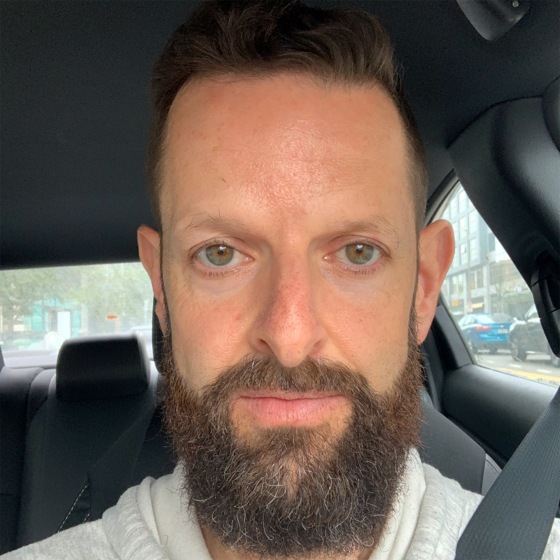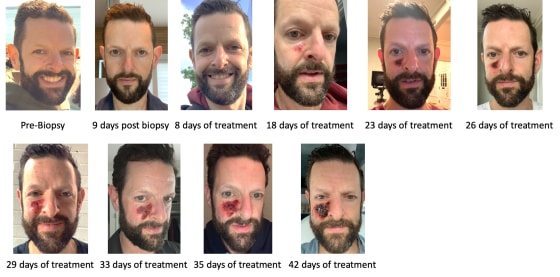Jeff Karp went to his first routine skin cancer check at the urging of his wife.

Jeff Karp on day 26 of his 42-day regimen with a cream to treat basal cell skin cancer on his cheek.Courtesy Jeff Karp
y A. Pawlowski
This past spring, Jeff Karp had just undergone his first full-body, routine skin cancer check and was about to walk out of the exam room, when, on a whim, the 46-year-old decided to ask his dermatologist about a spot on his cheek.
It was small — less than half an inch across — and faintly red. Karp first noticed it a year or two earlier, but thought it was part of the aging process. Everything during his full-body scan was normal, the visit was over, and he had already put his mask back on, so the question came out of the blue.
“I kind of debated whether I should ask about it or not,” Karp, Ph.D, a biomedical engineer and professor of medicine at Brigham and Women’s Hospital, told TODAY. “The thought didn’t even cross my mind that it could be skin cancer.”
But that’s exactly what it was. Karp’s dermatologist took a closer look and recommended a biopsy.
The results: basal cell carcinoma, the most common type of cancer in the world, according to the American Academy of Dermatology.

The cancer can look like a pink or reddish growth that dips in the center, a sore that doesn’t heal or a spot that feels scaly.
Karp recalled getting “some pretty severe (sun) burns” when he was younger. He used to play two rounds of golf a day, staying out in the sun for eight to 10 hours. The scientist said he used sunscreen “here and there” but wouldn’t necessarily reapply it.
sn’t until March that he finally went.
The question he asked at the very end of his visit is known as the “doorknob phenomenon,” when a patient waits until the doctor has his or her hand on the doorknob to leave the exam room to reveal something that often provides crucial information.
After his diagnosis, Karp was getting ready to have surgery to remove the skin cancer when the surgeon noticed it wasn’t too deep and recommended using Aldara, a cream to treat superficial basal cell carcinoma, instead.
Karp was prescribed a six-week treatment, applying the cream five days a week, with weekends off. He chronicled the startling skin changes during that time by taking a photo most every day.

"It's very shocking," Karp said of the way his skin looked during treatment. These photos show the recovery in the days after the treatment ended.Courtesy Jeff Karp

Everywhere I went, I was thinking, 'What are other people going to think and am I going to make other people uncomfortable?'" he said.Courtesy Jeff Karp
As a scientist who invents medical technologies and is fascinated by how things work, Karp explained the treatment this way:
“This cream is actually topical immunotherapy. It activates the local immune system in a very major way so that your immune system can then recognize the cancer cells and kill them,” he said.
Recommended

Karp, who recently finished the treatment, said his skin is expected to fully regenerate and return to normal or even better than it was before. But navigating the world during the treatment was challenging, he recalled.
That area of his face was uncomfortable and sometimes oozed with blood, so he had to sleep with a towel on his pillow. Children stared at Karp when he was out in public, and he avoided making eye contact with people or walking near them because he didn’t want to make them uncomfortable. It took a toll on his mental health.
“When it got to the last couple weeks of the treatment, I debated whether I should stop it because I was just getting really down about it,” he said. “Now, I’m in this very positive space because the treatment is over. I’m clearly on the road to recovery, and I’m not as self-conscious about it.”
Link:
https://www.today.com/video/melanoma-detection-and-diagnosis-how-to-spot-the-warning-signs-139084357784Karp now wears a wide brimmed hat outside and takes an umbrella with him for extra sun protection at outdoor events, like watching his son play football. He keeps sunscreen in his car and bag so it’s always accessible. He hopes others can learn from his ordeal and be more motivated to protect their skin, he recently wrote online.
When it comes to skin checks, dermatologists stress that patients need to be a partner in the process. Think of yourself and your dermatologist as a team. In between appointments, scan your body and take pictures of your moles to track any changes and show them to your physician.
“Everyone should get really familiar with their own moles because that’s what’s going to save your life,” Dr. Julie Karen, a board-certified dermatologist in New York City, previously told TODAY.
As for the “doorknob” question, Karp wasn’t surprised that that’s what it took to receive a diagnosis and stressed the importance of "collaboration with the dermatologist."
“(It’s) not just going in for a routine check, but also bringing to the attention of the dermatologist changes that you’ve observed over time that may require a deeper look," he said
Source:
https://www.today.com

